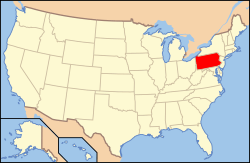Biery's Port Historic District
Biery's Port Historic District is a national historic district located in Catasauqua, Lehigh County, Pennsylvania. The district includes 90 contributing buildings in the Biery's Port section of Catasauqua. It consists mainly of mid- to late-19th century dwellings, with some 2 1/2-story stone dwellings built in the early 19th century by Frederick Biery. Notable non-residential buildings include the Americana Hotel (1852) and Dery Silk Mill.[2]
Biery's Port Historic District | |
Dery Silk Mill, October 2012 | |
  | |
| Location | Roughly bounded by Pineapple, Front, Race, and Mulberry Sts., Catasauqua, Pennsylvania |
|---|---|
| Coordinates | 40°38′57″N 75°28′04″W |
| Area | 21 acres (8.5 ha) |
| Architectural style | Late Victorian |
| NRHP reference No. | 84003457[1] |
| Added to NRHP | August 9, 1984 |
It was added to the National Register of Historic Places in 1984.[1]
History
Biery’s Port is the oldest section of Catasauqua, Pennsylvania, a borough in Pennsylvania which was initially settled in 1805 and, in 1839, became the first community in the United States to launch anthracite iron manufacturing operations. The site of several of Catasauqua's first commercial and residential buildings, Biery's Port became "the commercial heart of a thriving town," according to historians at the Delaware and Lehigh National Heritage Corridor."[3]
According to Lehigh Valley historian William H. Glace, David Thomas, a native of Glamorgan, South Wales who had become an iron worker at the age of 17 and then supervisor of the blast furnaces at "the Yniscedwyn Iron Works in the Swansea Valley", was recruited by Pennsylvania's Lehigh Coal and Navigation Company to erect "a furnace and run it successfully for three months by the exclusive use of anthracite coal for fuel." Lehigh Coal then "selected Biery's Port along the Canal, three miles above Allentown (afterwards named Catasauqua) as the locality for their great undertaking." Thomas, who emigrated from South Wales in 1839 and subsequently rented a home in Allentown with his family after arriving on July 9 of that year "until the two-story frame dwelling at Biery's Port was completed for them by the Crane Iron Co.," successfully completed his initial assignment for Lehigh Coal, leading to the formation of the Lehigh Crane Iron Company (which later became known simply as the Crane Iron Company) and, in the process making him a wealthy man and local philanthropist. Per Glace, Thomas "took much interest in the political, financial, religious and charitable affairs of the town, and therefore he came to be commonly recognized as its founder," and was also "particularly concerned in the establishment and success of the First Presbyterian Church of Catasauqua, and encouraged temperance and thrift amongst the numerous workingmen under him."[4]
Gallery
References
- "National Register Information System". National Register of Historic Places. National Park Service. July 9, 2010.
- "National Historic Landmarks & National Register of Historic Places in Pennsylvania" (Searchable database). CRGIS: Cultural Resources Geographic Information System. Note: This includes Paul Doutrich and Janice Lathrope (n.d.). "National Register of Historic Places Inventory Nomination Form: Biery's Port Historic District" (PDF). Retrieved 2011-10-29.
- "Biery's Port Historic District". Easton, Pennsylvania: Delaware and Lehigh National Heritage Corridor website, retrieved online February 15, 2019.
- Glace, William H. Early History and Reminiscences of Catasauqua in Pennsylvania, pp. 19-33. Allentown, Pennsylvania: Searle & Dressler Co., Inc., 1914.
| Wikimedia Commons has media related to Biery's Port Historic District. |

